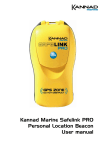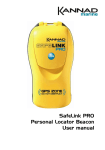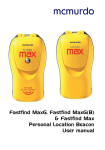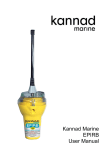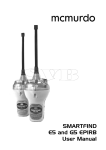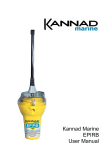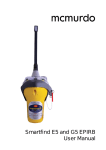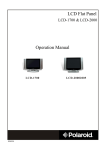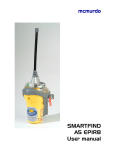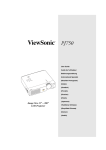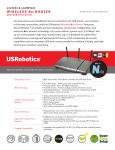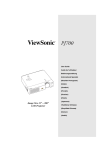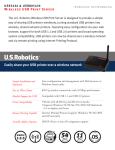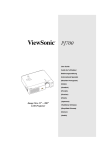Download Manual - Cordland Serviceport.se
Transcript
mcmurdo Fastfind MaxG & Fastfind Max Personal Location Beacon User manual ii Notices to Purchasers Personal Location Beacons (PLB) must be registered with the appropriate National Authority. Failure to register your PLB could delay a Search and Rescue (SAR) response and maybe un lawful. Your PLBs unique identification information Stick copy Programming label here WARNING A PLB should only be activated in situations of grave and imminent danger to life. Misuse or false activation is unlawful and could result in a penalty Important PLBs are intended for use within the maritime, aviation and land environments where permitted by national administrations. When activated, the PLB sends an emergency alert to the COSPAS-SARSAT satellite system. The time taken for the alert to be processed is dependant upon the extent of satellite system coverage at that time and any overhead obstruction that could impair the signal path to the satellite. The actual time to rescue in an emergency will be dependant upon the performance of all factors within the SAR (Search and Rescue) system, and as such, is outside the control of McMurdo. Applicability of this manual Fastfind Max and MaxG build standard: February 2008 This manual is applicable to both the Fastfind Max & MaxG models. The MaxG has an inbuilt GPS receiver, consequently any references to GPS and the GPS system will only apply to the MaxG model. i Contents Safety notices............................................................................................... 1 Quick start checklist ..................................................................................... 2 Emergency operation ........................................................................................... 2 Introduction................................................................................................... 3 Preparing the PLB for use............................................................................ 3 Handling false alerts..................................................................................... 4 Emergency Operation .................................................................................. 5 Switching off an active PLB.................................................................................. 6 Emergency Operation with GPS (Fastfind MaxG) ................................................ 7 Self-test ........................................................................................................ 8 Getting the best from the PLB...................................................................... 9 General use.......................................................................................................... 9 Get the best from GPS PLBs ............................................................................... 9 Satellite Distress Beacons explained ......................................................... 13 Why GPS PLBs? ................................................................................................ 13 How does your PLB work?......................................................................... 14 Registration and Licensing......................................................................... 15 Radio transmitter Licence requirements............................................................. 16 Service and Maintenance........................................................................... 17 Deactivation................................................................................................ 18 Battery Pack ............................................................................................... 18 How to assemble your PLB........................................................................ 19 Fitting the battery................................................................................................ 19 Technical Specifications............................................................................. 20 Usage statement ................................................................................................ 22 Declaration of Conformity........................................................................... 23 Product Warranty ....................................................................................... 25 End of Life Statement.................................................................................26 Battery Removal................................................................................................. 26 Disposal ............................................................................................................. 26 Annex 1. Registration information .............................................................. 27 Annex 2. Quick user card detail ................................................................. 30 ii Safety notices Please take time to read this manual fully as it contains important information regarding the correct use and maintenance of your PLB. Important The PLB (Personal Locator Beacon) is an emergency radio beacon; only ever operate it in situations of grave and imminent danger to life. CAUTION: False alerts endanger lives and cause expensive disruption to Search and Rescue services, deliberate misuse of the PLB could result in penalty. CAUTION: The PLB and battery pack contain no user-serviceable parts. Do not dismantle the PLB or the battery pack. CAUTION: The battery pack contains lithium batteries. Do not attempt to recharge the battery under any circumstances. Do not incinerate, puncture, deform, or short-circuit. Dispose of spent battery packs safely and in accordance with local waste disposal regulations. Refer to End of Life Statement. CAUTION: Avoid using chemical solvents to clean the PLB as some solvents can damage the case material. CAUTION: Radio licensing, the PLB is a radio transmitter. Some administrations may require that the user holds a valid radio licence to cover its ownership and use. Radio Frequency Exposure Warning WARNING: The PLB is a radio transmitter which emits radio frequency radiation when activated. Because of the low power levels used and the intermittency of these transmissions PLBs should not expose users to RF energy in excess of safe limits. However it is advisable not to handle the antenna while the unit is transmitting. Disclaimer McMurdo is a brand name operated by Signature Industries Limited. The information and illustrations contained in this publication are to the best of our knowledge correct at the time of going to print. We reserve the right to change specifications, equipment, installation and maintenance instructions without notice as part of our policy of continuous product development and improvement. No part of this publication may be reproduced, stored in a retrieval system or transmitted in any form, electronic or otherwise without permission in writing from McMurdo, Signature Industries Limited. No liability can be accepted for any inaccuracies or omissions in the publication, although every care has been taken to make it as complete and accurate as possible. 1 Quick start checklist Emergency operation 1. Open the flip cover 2. Tear off the red plastic tab 3. Press and hold the red button for 2 seconds Do • Register the PLB with the National Authority • Learn how to activate and position the PLB in an emergency • Check that the battery is in date • Self-test the PLB once a month • Activate the PLB unless there is a genuine emergency • Allow the GPS ZONE to become covered (clearly marked on the front of the PLB case) • Handle the antenna Don’t 2 Introduction Thank you for purchasing your McMurdo Fastfind Max or MaxG Personal Location Beacon (PLB). The Max range are the very latest state of the art McMurdo PLBs manufactured by Signature Industries Limited . When carrying a Fastfind Max, you will enjoy the reassurance of having a PLB as a last resort safeguard against any life threatening incidents that may occur anywhere in the world. Whether alone or in a group, on holiday or at work, enjoying your sport or hobby, if you ever find yourself in a remote area without any other form of emergency communication, on land, at sea or in the air the Fastfind Max comes into its own. Once activated, the Fastfind Max transmits a unique identification signal via the COSPAS SARSAT satellite system. Provided the PLB has a clear view of the sky its location can be determined anywhere on the earth’s surface. Details of the PLB alert will quickly be passed to regional SAR (search and rescue) authorities. Keeping your PLB Registration details up to date is critical to ensure a quick and appropriate SAR response is sent to your rescue. The Fastfind MaxG has an inbuilt Global Positioning System (GPS) navigation receiver. Once activated in an emergency, GPS positional information is automatically transmitted as part of the distress message. The inclusion of GPS based positional information can greatly reduce the time it takes for the SAR authorities to arrive on scene. Should your have any questions, or require advice regarding McMurdo products our website ‘frequently asked questions’ is a good place to start. From the web site you can also leave a message for our customer service team, visit; www.mcmurdo.co.uk Preparing the PLB for use Carefully unpack the carton and check the contents. Carton contents list; PLB with attached battery and Lanyard Belt bag User manual User card Registration paper work Confirm that the battery expiry date shown on the rear of the battery pack is in date for the duration of intended use. Check that the outside of the PLB is undamaged and that the flip top lid cover is present. Lift the flip top lid and confirm that the anti-tamper seal is intact Self-test the PLB following the instructions detailed in the self test section. A self-test pass indication verifies that the PLB is ready for use. Always carry the PLB securely, so it is close at hand in the event of an emergency. Securely attach the PLB lanyard clip to clothing or life vest. 3 Handling false alerts If the PLB has been accidentally activated, or if rescue has been effected before arrival of the rescue services: • Only switch off the PLB when instructed to do so by the rescue services or authorities. • Attempt to contact the rescue services, coastguard, or police by radio or telephone to advise them of the false alert. PLB antenna deployed 4 Emergency Operation Anti-tamper cover seal Flip-top lid GPS ZONE do not cover (Fastfind MaxG) Activation button Green light Red light Self-test/OFF button PLB controls (Max) 5 Emergency Operation Important: ONLY pull the red anti-tamper seal in an emergency. 1. Raise the flip-up lid to expose the red anti-tamper cover. Once opened, the flip-up lid can be pulled off the PLB and discarded if necessary. 2. Grasp the handle part of the red anti-tamper cover, and pull sharply away from the PLB body. This uncovers the START/ON button. The antenna will spring into an upright position as soon as the anti-tamper cover is removed. CAUTION: Spring action antenna deployment; tilt the PLB away from your face when pulling the anti-tamper seal to deploy the antenna. 3. Press and hold the ON button for at least 2 seconds. The RED ON indicator light will turn on An audible alarm buzzer will start to sound 4. After 2 minutes has elapsed, the RED ON indicator light will start to slowly flash indicating that the PLB has started transmitting emergency alerts. The PLB will continue to transmit alerts for a minimum of 48 hours. 406 MHz transmissions are announced by a long flash of the GREEN indicator light once every 50 seconds and the sounding of the audible alarm buzzer. Lift flip cover and Pull anti-tamper cover to deploy the antenna, push and hold ON button to activate the PLB. Important: After the PLB is switched ON the first emergency transmission is delayed for 2 minutes. This delay allows time to switch the PLB off in the event of accidental activation before a false alert is transmitted. Switching off an active PLB Press and hold the OFF button for a minimum of 5 seconds until the indicator lights go off and the alarm buzzer stops sounding. 6 Emergency Operation with GPS (Fastfind MaxG) When the PLB is first activated the inbuilt GPS receiver will attempt to acquire a valid geographical position fix. Once a GPS position fix is acquired the GREEN indicator light will start to flash once every 3.5 seconds in sequence with the red indicator light. - 3.5 seconds - 3.5 seconds GPS position acquired GREEN and RED indicator lights ‘long flash’ in sequence once every 50 seconds to indicate each 406 MHz transmission containing a valid GPS position. - 50 seconds Transmission with valid GPS position After 4 hours without a valid GPS position fix the GREEN light will go out completely. --50 50seconds seconds-GPS position lost Activation button Green light flashes when GPS position is good Red light Self-test/OFF button GPS PLB controls (MaxG) 7 Self-test International regulations require that Self-testing of the PLB should only be carried out in the first five minutes of any hour. Self-test verifies operation of the PLB by checking key features including battery voltage and 406 MHz and 121.5 MHz alert transmitters. Important Each self-test draws small amounts of energy from the battery pack. Unnecessary testing of the PLB may subsequently reduce the run time of the PLB in an emergency. On average, the PLB should only be self tested 12 times per year, or a total of 60 times across the 5 year battery lifetime. To operate self-test, use the Test/OFF button, located under the flexible handle of the red anti-tamper cover. • Open the flip-top lid. Do NOT pull off the red anti-tamper cover. • Slide a finger under the flexible handle of the anti-tamper cover to locate the Test/OFF button. • • Hold down the Test/OFF button for 10 seconds. (red ON indicator light will illuminate) • Self-test pass is indicated by 3 flashes of the green indicator light and the alarm buzzer will sound. • A failed self-test is indicated by 3 flashes of the red ON indicator light • The PLB will switch off once the self-test has finished Self-test • Release the button and close the flip-top lid. 8 Important: While self-testing keep your fingers away from the top of the PLB as the close proximity of any objects can affect the results of the self-test. If the self-test still fails, repeat it and if the problem persists remove the PLB from use and contact your service dealer for advice. Getting the best from the PLB General use Once activated, position the PLB so that the antenna is pointing straight up towards the sky so that it has the best all-around view of the sky. The position of the COSPASSARSAT satellites can affect when an alert signal is received. Careful positioning so that the maximum amount of sky is in view will produce the optimum performance. Get the best from GPS PLBs Position the PLB so that the antenna is pointing skyward and the GPS zone is clear of any obstructions. YES NO Do not obstruct the area marked GPS Zone on top of the PLB The PLB should be positioned to have the clearest possible view of the sky, obstructions such as tree cover, deep canyons, ravines, caves, overhangs and shadowing objects can block out the view of GPS satellites and may inhibit GPS signals from reaching the PLB. 9 Even if the GPS PLB initially fails to acquire a valid GPS position, the first alert message will still be transmitted within 2 minutes of activation. The PLBs position will be determined as if it was a standard PLB without GPS. Using the PLB afloat The PLB is totally waterproof but is not designed to operate when floating on the surface of the water. It is buoyant and will not sink if dropped into water, if possible keep it out of the water when in use, place it high up on your PFD, lifejacket. or chest and clear of any wave wash. Any trapped water should be removed periodically by shaking the PLB. Aboard a liferaft The principle is to give the PLB as clear a view of the sky as possible whilst keeping it flat. If the raft is full, it may be necessary to elevate the PLB or hold it outside the liferaft canopy. Attach the lanyard to your clothing so in the event of separation from the life raft the PLB will stay with you. Aboard ship Operate the PLB on deck; position it to have the clearest possible view of the sky. Lay it flat on the deck with the antenna pointing up towards the sky . Aviation The PLB is not designed for activation aboard an aircraft although they are often used as an additional carry off safety device. Take care not to place the PLB in the shadow of the aircraft. Lay it on a flat surface with the antenna pointing up towards the sky and with the maximum amount of sky possible in view. Vehicles Because of the shielding effect, the PLB probably will not operate effectively when inside a vehicle. It is best placed outside on the roof, hood or trunk. 10 On the move If on the move, take care to keep the PLB flat with the antenna pointing skyward. Using the PLB on land The PLB should be placed to have the clearest possible view of the sky. Make sure the PLB does not become covered by drifting material (eg snow, sand). Keep it flat with the antenna pointing upwards. Do not stand over the PLB. NO OK Try to move the PLB into a clearing and out of thick tree cover 11 It is ESSENTIAL that you register your PLB Registration helps reduce the number of false alarms and hoax calls, and so makes the rescue service more efficient. It is important to update your registration details if your address or 24 hour contact details ever change. On receipt of a PLB alert, the SAR organization will firstly try to check that the registered owner of the PLB has not accidentally activated the beacon. To do this, they will try to confirm the approximate location by calling the 24 hour contact number filed at the time the PLB was registered. You should always ensure that your 24 hour contact details are up to date and that they know where you are likely to be located. For the same reason, if you ever lend your PLB to anybody you should always know were they are going. Carrying your PLB The standard belt bag provides a convenient way to carrying the PLB hands-free. Fit the bag to your belt. Invert the PLB and place in the bag with the lanyard uppermost. To prevent loss of the PLB, attach the free end of the lanyard (clip) securely to your clothing or belt. Divers can purchase the optional PLB dive canister, turned from solid marine grade aluminium and pressure tested to 150m (500ft). PLB Belt Bag PLB dive canister option, the ultimate protection for your PLB tested to a depth of 150m 12 Satellite Distress Beacons explained Satellite Distress Beacons such as Personal Locator Beacons (PLBs) are used to alert search and rescue services in the event of an emergency. They do this by transmitting a coded message on the international 406 MHz distress frequency which is relayed via satellites and earth stations to the nearest rescue co-ordination centre. * System graphics courtesy of COSPAS SARSAT. Cospas Sarsat explained The Cospas-Sarsat satellite system has global coverage that provides a typical time to alert notification of between approximately 3 and 45 minutes. The geographical location of a GPS PLB (with inbuilt GPS receiver) can normally be resolved within 5 minutes and 45 minutes for a non-GPS PLB. The time to alert is dependant on which satellites are in view in the sky at the time of PLB activation. Non-GPS PLBs rely on passing orbiting satellites to determine an approximate position, this can take longer and the resolved position is less accurate than can be achieved compared to a GPS PLB. Why GPS PLBs? GPS PLBs have been designed to enhance further the lifesaving capabilities of conventional distress beacons. When a GPS PLB is activated in an emergency, GPS positional information is automatically transmitted as part of the distress message. The Global Positioning System (GPS) has an array of orbiting satellites and provides the PLB with positional information and with new positional updates occurring every 13 20 minutes. The inclusion of GPS based positional information can greatly reduce the time it takes for the SAR authorities to arrive on scene. When speed of response and accuracy of location are important considerations, then GPS PLBs offer the best in performance. The location of a GPS PLB can be determine to a typical positional accuracy of about +/- 62 metres (0.03 miles) within a few minutes of PLB activation and a non-GPS PLB within about +/- 5km (3 miles) and typically within 45 minutes. PLBs also have a secondary homing transmitter. This transmits on the 121.5 MHz internationally recognised aviation guard channel. When the rescue services get close they can "home in" on this signal using direction finding techniques. More than 22,000 lives have been saved by distress signals routed via the COSPASSARSAT* system since it was installed in 1996. * For an full explanation, visit the Cospas-Sarsat web site: http://www.cospas-sarsat.org How does your PLB work? The PLB has two radio transmitters which start transmitting when you activate the PLB. One transmitter operates at 406 MHz which transmits alerts via satellites. The other operates at 121.5 MHz which transmits a signal which can be received by overflying aircraft and Search and Rescue homing receivers. Ground stations track the satellites and process the distress signals to obtain a location of the distress. The processed information is then forwarded to a Mission Control Centre where it is combined with PLB registration information and passed to a Rescue Coordination Centre which alerts the appropriate Search and Rescue authorities. Successive satellite passes refine and confirm the original information. PLBs with inbuilt GPS receivers determine their own geographical position and transmit it as part of the distress alert signal. Locations where the sky area is obscured significantly, such as under a tree canopy or in a steep-sided canyon, may result in delays in GPS position fixing. In extreme circumstance, the PLB may fail 14 completely to get a valid GPS position. If this happens, the GPS PLB “fails safe” and does not transmit an inaccurate position but instead sends information to indicate that no position is available. Location of the PLB without GPS position information is dependent on the orbiting satellite system just like with a non-GPS PLB. PLBs have a secondary 121.5 MHz homing transmitter. This transmits on the 121.5 MHz internationally recognised aviation guard channel. If an aircraft hears an activated beacon, it will often make a report to the aviation authority which will pass this information to the Rescue Coordination Centre. When the rescue services get close they can "home in" on the 121.5 MHz signal using direction finding techniques. Registration and Licensing Each PLB has a unique digital identity; this is the 15 digit hexadecimal number printed on the programming information label located on the back of the PLB (visible only when the battery pack is removed). It is also pre-printed on the registration form included with each new PLB and a copy of the programming information label is usually placed on the first page of this product user manual. The PLB must be registered with a relevant national authority. A part completed registration form is normally packed in with the PLB, were required this should be completed and sent to the relevant national administration at the address detailed on the registration form. If your form does not have a registration address, contact your supplier for further advice. Annex 1. Contains further important information regarding registration of the PLB. Registration decal It is usual to receive confirmation after you have correctly registered the PLB. Some administrations (USA, UK) will send you a registration decal (sticker) which must be attached to the PLB, as shown below. Registration decal Typical decal being fitted 15 WARNING: Do not attempt to fit the decal in any other position, as this could interfere with the battery seal or with the operation of the PLB. Radio transmitter Licence requirements The PLB is a radio transmitter, some administration require that the user holds a valid radio licence to cover its ownership and use. Radio Licensing regulations vary from nation to nation. Your supplier should be able to offer advice regarding any local licensing requirements in your country of residence, or you should contact your national communications licensing authority directly. Note for US PLB owners, A Radio Licence is not required to own or operate a PLB within the confines of the USA. 16 Service and Maintenance Before use Check the PLB monthly, check the battery expiry date has not expired, run self-test and examine for any signs of damage to the outer case. After use (not activated) Clean the outer case with fresh water, wipe dry and examine for any damage. Store in a cool dry place until next needed, self-test the PLB monthly. CAUTION: Avoid using chemical solvents to clean the PLB as some solvents can damage the case material. After activation The antenna must be re-wound (see below) WARNING: The battery will be partly or fully run down and must be replaced. Inadvertent antenna deployment If the red anti-tamper seal is defeated, then the antenna will automatically deploy. Rewinding of the antenna and fitting of a new anti-tamper seal can only be done by a McMurdo authorised service station. For safe transportation, wrap the antenna around the body of the PLB and fix in place with adhesive tape. Do not close or fold the flipup lid over the top of the deployed antenna as this may damage the antenna. NOTE: Antenna re-winding will incur a service charge. CAUTION: never attempt to re coil the antenna Method of taping antenna Service Battery packs, flip cover and lanyard are user replaceable. The main body of the PLB has no user-serviceable parts. A list of McMurdo dealers and Service Agents is located on the McMurdo web site, www.mcmurdo.co.uk. Spare Parts Battery pack, Class 2, -20 °C Replacement belt bag Max replacement flip cover MaxG replacement flip cover Replacement lanyard 85-763-020 85-736-004 85-877-001 85-877-002 85-769 17 Deactivation The PLB may be completely deactivated by removing the battery pack. Important: When the battery pack is removed the PLB is no longer fully environmentally sealed and should not be subjected to water. Battery Pack The battery pack is easily user replaceable. Once the battery expiry date has been reached it must be replaced. only fit an original McMurdo branded -20 °C Class 2 Battery Pack Part No. 85-763-020 Battery packs provide a minimum of 48 hours continuous operation at a minimum temperature of -20 °C (-4 °F). and maximum of +55 °C (+131 °F). The battery may safely be stored in temperatures up to +70 °C (+158 °F). CAUTION: this product should only ever be fitted with a -20 °C Class 2 Battery Pack McMurdo Part No. 85-763-020. CAUTION: Never attempt to recharge the battery Pack 18 How to assemble your PLB Fitting the battery Take care when fitting the battery. It forms part of the sealing system of the PLB, so it is important to follow the instructions exactly. Each replacement battery pack has new ‘O’ rings which should be replaced when the battery is changed. 1. Fit the two ‘O’ rings to the battery connectors, as shown below. 2. Clip the battery pack into the PLB, then push the battery pack into place. Take care that the ‘O’ rings stay in place. ‘O’ rings fitted to battery connectors 3. Fit the battery screw block (lanyard securing tag). It is essential that the screw block is fitted, as it forms part of the PLB sealing system. Battery retaining screw Battery screw block must be fitted even if the lanyard is not required. (lanyard removed for clarity) 4. Fit the screw to retain the battery pack and tighten until resistance is felt, then turn the screw one 360° additional turn (torque setting 25 cNm). 5. Perform a self-test, (see page 11). If the PLB does not pass the self-test, repeat it once. If the PLB still does not pass the self-test, contact McMurdo or your dealer for further advice. 19 Technical Specifications Part Number: 85-880-001A Fastfind Max PLB retail pack Part Number: 85-890-001A Fatfind MaxG GPS PLB retail pack 20 Fastfind Max and Fastfind MaxG Specification General Approved to COSPAS-SARSAT T.007 Class 2, TAC-184 Internationally type approved, a list of current type approvals is held in the Fastfind Max section of the McMurdo web site; www.mcmurdo.co.uk Complies with relevant clauses EN 60945 RTCM 76-2002/SC110-STD V1.1 Operating temperature range Storage temperature range -20 °C to +55 °C -30 °C to +70 °C Operational life, Class 2 48 hours minimum at –20 °C Battery type, Class 2 Battery expiry Typical in service battery life 11 V lithium iron disulphide 6 years from date of manufacture 5 years Electrical 406.037 MHz transmitter Frequency Output power Data encoding Modulation Transmission time Repetition period 406.037 MHz +1 kHz 5 W+2 dB Bi-phase L Phase modulation; 1.1 rads +0.1 rads 520 ms +1% GPS, 440 ms +1% non-GPS 50 secs +2.5 secs 121.5 MHz transmitter Frequency Output power Transmit duty cycle Modulation format Modulation frequency sweep Modulation duty cycle Morse code modulation Sweep repetition rate Sweep direction 121.5 MHz +3 kHz 50 mW +3 dB PERP 100% 3K20A3X 1300 Hz to 350 Hz 41%+5% Letter ‘P’ (programming option) 3 Hz +1 Hz Programmable UP or DOWN GPS receiver/engine Centre frequency Received signal sensitivity Maximum number of satellites tracked Indication of GPS position (Fastfind MaxG only) Band L1 1.57542 GHz -175 dBW minimum 12 Visual 21 Transmit antenna Type Characteristics Flexible vertical tape monopole Vertically polarised, omni-directional Receive antenna Type Characteristics (Fastfind MaxG only) Ceramic dielectric patch RH circular polarised, gain +3 dBi nominal External interfaces Programming interface Manual activation Self test/Manual deactivation Infra-red diode Sealed membrane switch with tamper cover Sealed membrane switch Physical characteristics Category Class Weight Length Width 2, manual activation 2 300 g 146 mm 78 mm Buoyancy Sealing Temporary immersion Lanyard Buoyant Waterproof to 5 m immersion 10 m 0.75m Sprung Kevlar with belt clip Communications Time to first transmission Typical time to alert Position accuracy 2 minutes LEOSAR: GEOSAR: Fastfind Max: Fastfind MaxG: 45 minutes 5 minutes 5 Km radius 62 m radius Usage statement PLBs are intended for use within the maritime, aviation and land environments where permitted by national administrations. This PLB is not an ELT or an EPIRB and does not meet the regulatory requirements for an ELT or an EPIRB. This PLB is buoyant, but is not required to float in an upright position. 22 Declaration of Conformity 23 24 Product Warranty McMurdo is a brand operated by Signature Industries Limited. Subject to the provisions set out below McMurdo warrants that this product will be free of defects in materials and workmanship for a period of 24 months from the date of purchase. McMurdo will not be liable to the buyer under the above warranty:• for any defect arising from fair wear and tear, wilful damage, negligence, abnormal working conditions, failure to follow McMurdo's instructions (whether oral or in writing) including a failure to install properly and/or to use batteries recommended and/or supplied by McMurdo, misuse or alterations or repair of the product by persons other than McMurdo or an Approved Service Agent; • for parts, materials or equipment not manufactured by McMurdo in respect of which the buyer shall only be entitled to the benefit of any warranty or guarantee given by the manufacturer to McMurdo; • for the battery storage life which is specifically excluded from this warranty; • if the total price for the product has not been paid. THE LIMITED WARRANTY STATED ABOVE IS EXCLUSIVE AND IN LIEU OF ANY OTHER WARRANTY, EXPRESS OR IMPLIED, INCLUDING BUT NOT LIMITED TO ANY IMPLIED WARRANTY OF MERCHANTABILITY OR FITNESS FOR A PARTICULAR PURPOSE. McMurdo will not be liable for indirect, special, incidental or consequential damages of any kind sustained from any cause. In no event shall McMurdo be liable for any breach of warranty or other claim in an amount exceeding the purchase price of the PLB. This warranty does not affect any statutory rights of the consumer. In order to be valid, claims must be made under the above warranty in writing as soon as practicable after discovery of the defect or failure and within the warranty period referred to above. Proof of purchase will be required. The claim should be sent together with the product in question to the address set out below or to an Approved Service Agent. Following a valid warranty claim McMurdo shall be entitled to repair or replace the product (or part) in question free of charge, or at McMurdo's sole discretion to refund to the buyer the price of the product (or a proportional part of the price). McMurdo shall not be liable to a buyer who is not a consumer for any other loss or damage (whether indirect, special or consequential loss of profit or otherwise) costs, expenses or other claims for compensation which arise out of or in connection with this product. In the case of a consumer McMurdo shall only be liable where other loss or damage is foreseeable. Nothing shall limit McMurdo's liability for death or personal injury caused by its negligence. This warranty is to be interpreted under English law. All enquiries relating to this warranty or Approved Service Agents should be sent to: McMurdo a Division of Signature Industries Limited, Silver Point, Airport Service Road, Portsmouth, Hampshire, PO3 5PB UK Telephone: Int + 44 (0) 23 9262 3900 Fax: Int + 44 (0) 23 9262 3998 Web: www.mcmurdo.co.uk Email: [email protected] 25 End of Life Statement At the end of the PLBs useful life, it is vital that the battery is removed from the main body of the unit to prevent false alarms. False alarms cause expensive disruption to Search and Rescue services and may endanger lives as a consequence. It is also necessary that the PLB and its battery pack be disposed of in a manner that does not present a threat of environmental damage. Battery Removal To remove the battery, turn the PLB over and undo the battery retaining screw using a flat-blade screwdriver. Gently prise the battery from the main unit (the lanyard securing lug can be used for leverage). Note that this will also release the ‘O’ ring seals for the battery terminals, as well as the lanyard securing lug. Cover the terminals of the battery pack with sticky tape to prevent inadvertent short-circuiting. Disposal The Waste Electrical and Electronic Equipment (WEEE) Directive aims to minimise any adverse impact of electronic equipment on the environment, both during the product lifetime and when it becomes waste. Within the European Union this legislation is mandated by Directive 2002/96/EC, and there is similar legislation in most other continents. The directive applies to all electronic products such as IT, household appliances, portable electronics etc., and imposes requirements to collect, treat, recover and recycle each product at its end of life. Electronic end-user products must also carry a WEEE label (as below) and recovery and recycling information has to be provided to the recycler. This PLB product contains traces of lithium in the battery pack. In addition it may contain lead and brominated flame retardants (BFRs), both in the housing material and circuit boards. In keeping with the directive, McMurdo strongly recommends that this PLB product and its battery pack be disposed of in a sensible and considerate manner. For example, do not simply discard the product in the domestic waste. Instead take it to a civil recycling facility, or contact McMurdo for advice. 26 Annex 1. Registration information PLBs must be registered with a relevant national authority. Some administrations allow for on line registration or require a completed registration application form to be submitted by letter or FAX. General information related to PLB registration requirements around the World is published by the Cospas Sarsat organisation. Some administrations now allow direct registration using the Cospas Sarsat website online IBIRD registration database. Further information can be found on line here: www.cospas-sarsat.org A registration form is normally packed with the PLB, if you are not registering the PLB online the form should be completed and sent to the relevant national administration at the address detailed on the form. Additional registration information by country Austria Point of contact: Frequency Office Federal Ministry for Transport Tel: +43 1 33181621 Fax: +43 1 33181649 Email: [email protected] Online registration: n/a Australia Point of contact: Beacon Registration Section, AusSAR Tel: +61 2 6279 5766 or 1800 406 406 Fax: +61 2 9332 6323 or 1800 406 329 Email: [email protected] Online registration: n/a Belgium Point of contact: IBPT Tel: +32 2 2268856 Fax: +32 2 2268802 Email: [email protected] Online registration: n/a Canada Point of contact: Canadian PLB registry Tel: 1-800-727-9414 or 1-613-996-1616 Fax: 1-613-996-3746 Email: [email protected] Online registration: http://beacons.nss.gc.ca Finland Point of contact: The Finnish Communications Regulatory Authority Tel: +358 9 69661 Fax: +358 9 6966410 Email / www: www.ficora.fi Online registration: n/a France Point of contact: FMCC Tel: +33 5 61274636 27 Fax: +33 5 61274878 Email: [email protected] Online registration: n/a Greenland (Denmark) Point of contact: Greenland Telecom Administration Tel: +45 35430333 Fax: +45 35431434 Email: n/a Online registration: n/a India Point of contact: INMCC/ISTRAC/ISRO Tel: +91 80 28371857 Fax: +91 80 28371857 Email: [email protected] Online registration: n/a Ireland Point of contact: Maritime Radio Affairs Unit Tel: +353 1 6782367 Fax: +353 1 6783109 Email: [email protected] Online registration: n/a Netherlands Point of contact: Radio Communications Agency Tel: +31 50 5877555 Fax: +31 50 5877400 Email: [email protected] www: www.agentschap-telecom.nl Online registration: n/a New Zealand Point of contact: Rescue Co-ordination Centre New Zealand Tel: +64 4 577 8033 Fax: +64 4 577 8041 Email: [email protected] Online registration: n/a Norway Point of contact: Post and Telecommunications Authority Tel: +47 2 2824600 Fax: +47 2 2824890 Email: [email protected] Online registration: n/a Portugal Point of contact: Navigation, Transport, Marine inspector Tel: +351 21 3913529 Fax: +351 21 3979794 Email: n/a Online registration: n/a South Africa Point of contact: SASAR, MRCC Cape Town Tel: +27 21 9383310 28 Fax: +27 21 9383319 Email: [email protected] Online registration: n/a Sweden Point of contact: MRCC Goteborg Tel: +46 31 699080 Fax: +46 31 648010 Email: n/a Online registration: n/a Switzerland Point of contact: Federal Office of Communications Tel: +41 32 3275511 Fax: +41 32 3275555 Email: n/a Online registration: n/a UK Point of contact: The EPIRB Registry, The Maritime and Coastguard Agency Tel: 01326 211569 Fax: 01326 319264 Email: [email protected] Online registration: www.mcga.gov.uk/c4mca/epirb USA Point of contact: United States 406 MHz beacon registration database system Tel: 1-888-212-SAVE (7283) Fax: (301) 568-8649 Online registration: www.beaconregistration.noaa.gov New Zealand Point of contact: Rescue Co-ordination Centre New Zealand Tel: +64 4 577 8033 Fax: +64 4 577 8041 Email: [email protected] Online registration: n/a Portugal Point of contact: Navigation, Transport, Marine inspector Tel: +351 21 3913529 Fax: +351 21 3979794 Email: n/a Online registration: n/a 29 Annex 2. Quick user card detail 30 31 McMurdo A Division of Signature Industries Ltd Silver Point Airport Service Road Portsmouth PO3 5PB United Kingdom Phone: Fax: Email: Website: +44 (0)23 9262 3900 +44 (0)23 9262 3998 [email protected] www.mcmurdo.co.uk 85-902-880 Iss. 1 32




































